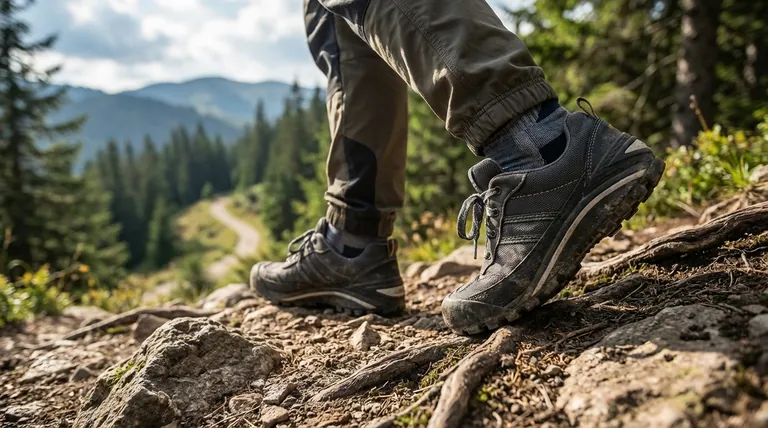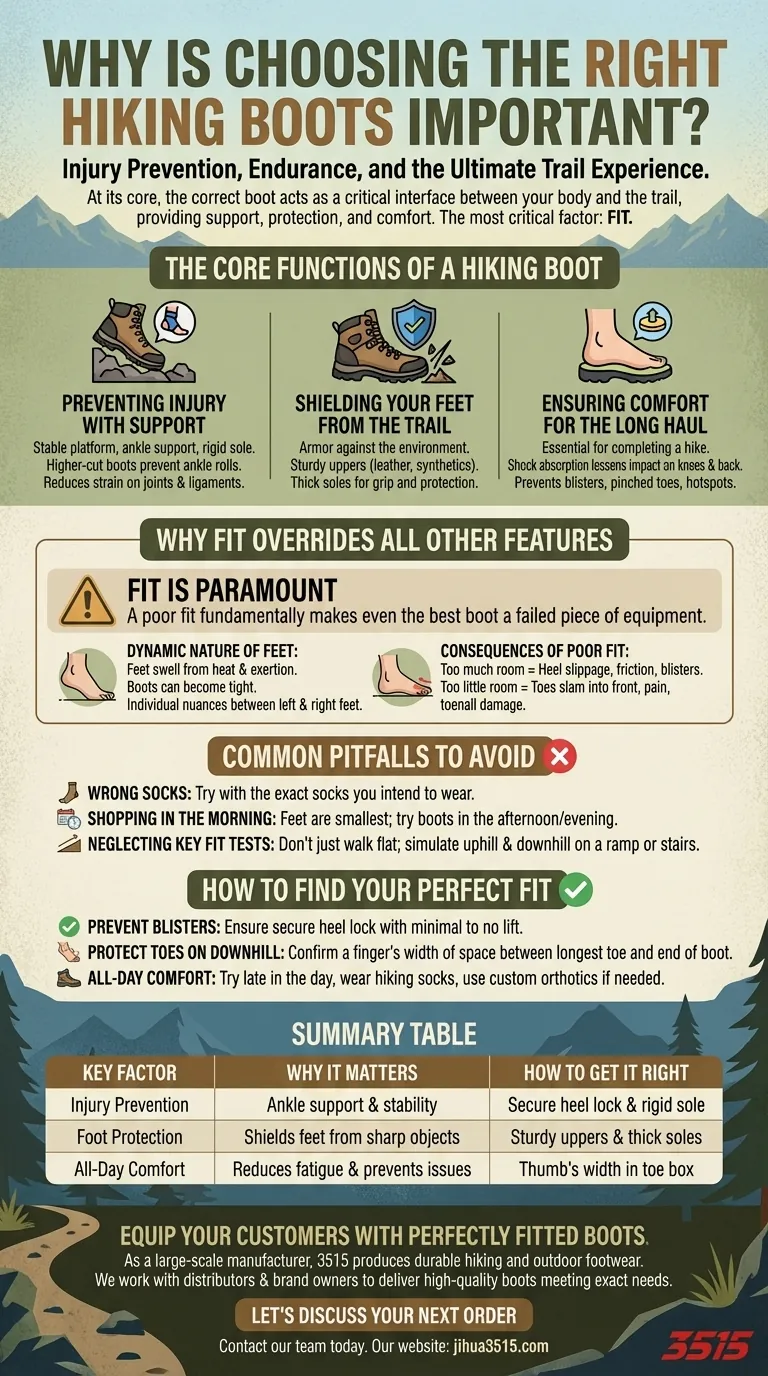At its core, choosing the right hiking boot is about injury prevention and endurance. The correct boot acts as a critical interface between your body and the trail, providing the support, protection, and comfort necessary to avoid pain and fatigue, ensuring your focus remains on the experience, not your feet.
The single most important factor in a hiking boot is not the brand, the materials, or the price—it is the fit. An impeccably designed boot that fits poorly is fundamentally a failed piece of equipment.

The Core Functions of a Hiking Boot
To understand why fit is paramount, we must first appreciate what a hiking boot is engineered to do. Its purpose goes far beyond simply covering your foot.
Preventing Injury with Support
A primary role of a hiking boot is to create a stable platform on unstable ground. This is achieved through a combination of a rigid sole and ankle support.
Higher-cut boots, in particular, help prevent ankle rolls on rocky or uneven terrain. This structural support reduces the strain on your joints and ligaments over miles of hiking.
Shielding Your Feet from the Trail
Hiking boots are your armor against the environment. Sturdy uppers made from leather or durable synthetics protect your feet from rocks, roots, and abrasions.
The thick, stable soles serve a dual purpose: they provide grip and protect the bottom of your feet from sharp objects, which significantly reduces foot fatigue.
Ensuring Comfort for the Long Haul
Properly fitted boots are essential for comfort, which directly impacts your ability to complete a hike. They provide adequate shock absorption to lessen the impact on your knees and back.
More importantly, a good fit prevents common issues like blisters, pinched toes, and hotspots that can quickly turn an enjoyable trek into a painful ordeal.
Why Fit Overrides All Other Features
A boot can have the most advanced waterproof membrane and the most durable sole, but if it doesn't match the unique shape of your foot, those features become irrelevant.
The Dynamic Nature of Your Feet
Your feet are not static. Over the course of a hike, they swell from heat and exertion. A boot that feels snug in the store can become painfully tight after just a few miles.
Furthermore, almost everyone has slight variations between their left and right foot. A successful fit must accommodate these individual nuances.
The Consequences of a Poor Fit
A poor fit manifests in specific, predictable problems. Too much room can cause heel slippage, leading to friction and blisters.
Too little room, especially in the toe box, will cause your toes to slam into the front of the boot during downhill sections, resulting in pain and potential toenail damage.
Common Pitfalls to Avoid
The process of finding the right fit is where most people make mistakes. Avoiding these common errors is critical to making a successful choice.
Trying Boots with the Wrong Socks
The thickness of your hiking sock is a significant variable. Always try on boots with the exact socks you intend to wear while hiking to get a true sense of the fit.
Shopping in the Morning
Your feet are at their smallest early in the day. To account for natural swelling, always try on new hiking boots in the afternoon or evening.
Neglecting Key Fit Tests
Don't just walk on a flat surface. Find a small ramp or stairs to simulate walking uphill and downhill. This will immediately reveal if your heel is slipping or your toes are hitting the front of the boot.
How to Find Your Perfect Fit
Making the right choice is a methodical process of replicating trail conditions inside the store. Use these principles to guide your decision.
- If your primary focus is preventing blisters and hotspots: Ensure your heel is locked securely in place with minimal to no lift as you walk.
- If your primary focus is protecting your toes on downhill sections: Confirm there is about a finger's width of space between your longest toe and the end of the boot.
- If your primary focus is all-day comfort: Always try on boots late in the day, wear your chosen hiking socks, and use any custom orthotics or insoles you normally wear.
Ultimately, investing the time to find the perfect fit is an investment in every future hike you take.
Summary Table:
| Key Factor | Why It Matters | How to Get It Right |
|---|---|---|
| Injury Prevention | Provides ankle support and stability on uneven terrain. | Look for a secure heel lock and rigid sole. |
| Foot Protection | Shields feet from sharp rocks, roots, and abrasions. | Choose boots with sturdy uppers and thick soles. |
| All-Day Comfort | Reduces foot fatigue and prevents blisters/hotspots. | Ensure a thumb's width of space in the toe box. |
Ready to equip your customers with perfectly fitted, high-performance hiking boots?
As a large-scale manufacturer, 3515 produces a comprehensive range of durable hiking and outdoor footwear designed for comfort, support, and protection. We work directly with distributors, brand owners, and bulk clients to deliver high-quality boots that meet the exact needs of hikers.
Let's discuss your next order: Contact our team today to explore our production capabilities and find the right footwear solutions for your market.
Visual Guide

Related Products
- Durable Rubber Sole Outdoor Shoes Wholesale & Custom Manufacturing
- Safety Footwear Wholesale Manufacturer for Custom OEM/ODM Production
- Durable Waterproof Rain Boots | Custom Manufacturer for Wholesale & Brands
- Wholesale Safety Footwear Manufacturer for Bulk & Custom OEM Orders
- Wholesale Durable Breathable Safety Boots Custom OEM Manufacturer
People Also Ask
- Why are rubber-soled shoes considered multi-weather footwear? Unlock All-Season Traction & Protection
- What are the main applications of vulcanized rubber? Unlock Durability for Tires, Footwear & More
- How do hiking shoes or boots protect feet from environmental hazards? A Guide to Trail-Ready Footwear
- What are the disadvantages of vulcanized soles? Lack of Support & Durability Explained
- Why are vulcanized soles popular in urban fashion? Discover the Legacy of Authentic Street Style



















